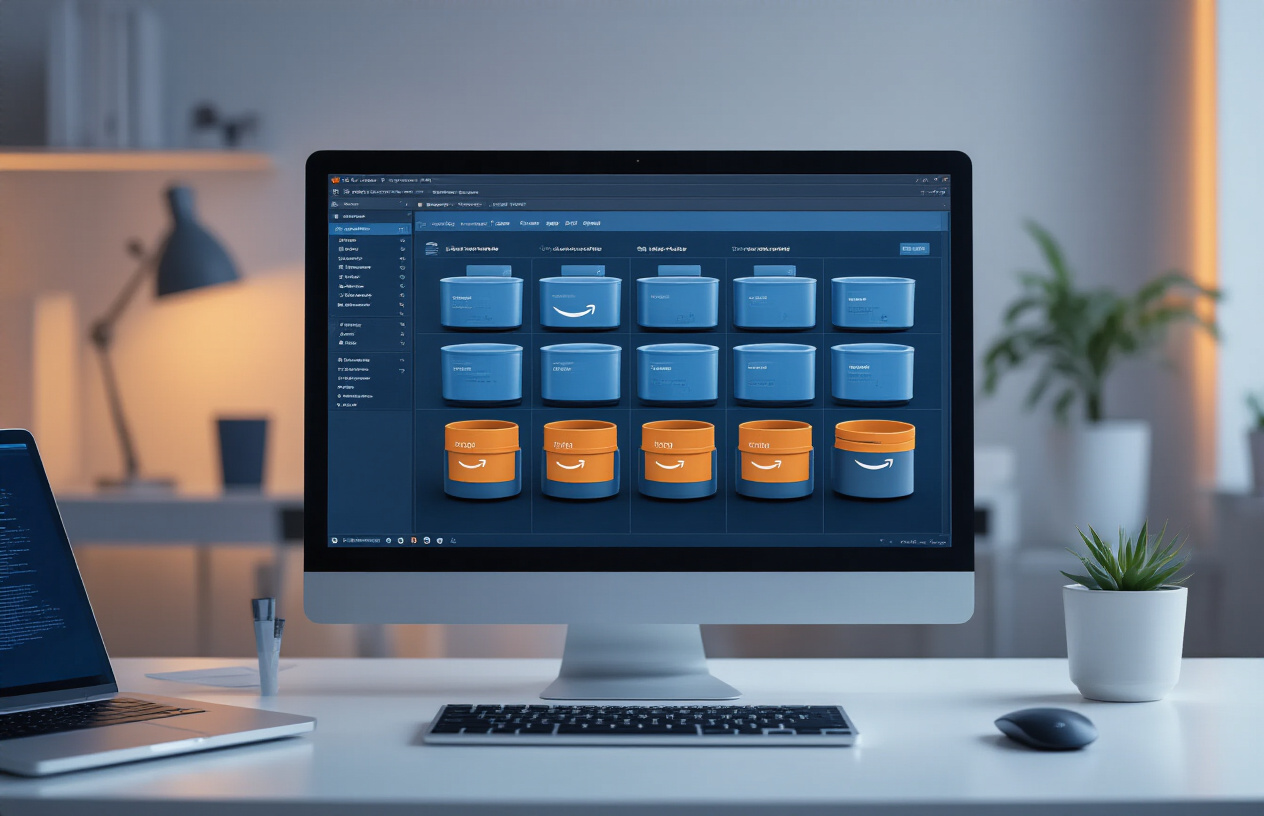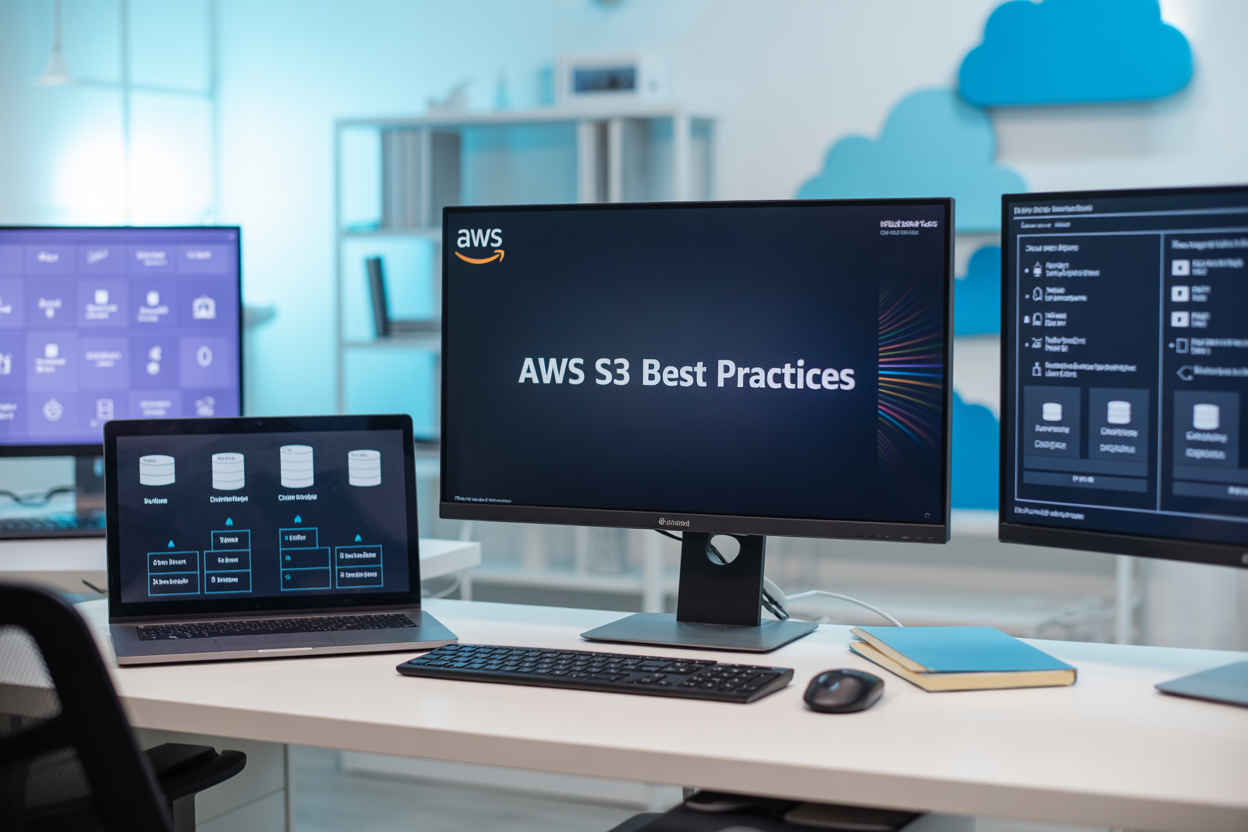Getting your AWS S3 buckets set up right from the start can save you from major headaches down the road. Poor naming choices and sloppy configurations often lead to security vulnerabilities, skyrocketing costs, and performance bottlenecks that could have been easily avoided.
This guide is for DevOps engineers, cloud architects, and developers who want to build rock-solid S3 infrastructure that grows with their applications. You’ll learn how to implement AWS S3 bucket naming conventions that prevent conflicts and boost performance, plus discover S3 bucket security best practices that keep your data locked down tight.
We’ll walk through essential S3 configuration strategies, including how to choose the right storage classes for maximum cost savings and set up bulletproof versioning systems. You’ll also get practical performance optimization techniques that help your S3 buckets handle heavy traffic without breaking a sweat.
Essential S3 Bucket Naming Conventions for Maximum Performance

Follow DNS-compliant naming rules to ensure global accessibility
AWS S3 bucket naming conventions play a crucial role in ensuring your buckets are accessible worldwide. Every bucket name must be unique across all AWS accounts and regions, functioning like a domain name in the global DNS system. This means your bucket name becomes part of the URL structure, directly impacting how users and applications access your content.
DNS-compliant names must be between 3 and 63 characters long and can only contain lowercase letters, numbers, and hyphens. The bucket name cannot start or end with a hyphen, and consecutive hyphens are not allowed. These rules exist because S3 integrates with the Domain Name System, and violating them can cause resolution failures or unexpected behavior when accessing your buckets through various AWS services.
When planning your naming strategy, consider that bucket names are visible in URLs and logs. A well-structured name like mycompany-production-assets immediately communicates the bucket’s purpose and environment, making it easier for team members to identify and manage resources.
Use lowercase letters and hyphens for consistent URL structure
Consistency in bucket naming creates predictable URL patterns that simplify both manual access and programmatic interactions. Using lowercase letters eliminates confusion since bucket names are case-sensitive, and mixing cases can lead to access errors or duplicate bucket creation attempts.
Hyphens serve as natural separators in bucket names, making them more readable than continuous strings of characters. For example, marketing-campaign-images-2024 is far more readable than marketingcampaignimages2024. This approach becomes especially valuable when working with multiple buckets across different projects or environments.
The lowercase-and-hyphens pattern also aligns with modern web standards and makes your bucket names compatible with various tools and scripts that may process them automatically. Many organizations adopt standardized formats like organization-environment-purpose or project-region-function to maintain consistency across their entire AWS infrastructure.
Avoid periods and underscores to prevent SSL certificate issues
While AWS technically allows periods in bucket names, using them creates significant complications with SSL/TLS certificates. When you access an S3 bucket using HTTPS with a period in the name, the SSL certificate validation can fail because the certificate is issued for *.s3.amazonaws.com, but bucket names with periods don’t match this wildcard pattern.
This limitation becomes particularly problematic when using S3 with CloudFront distributions, API Gateway, or any service that requires secure connections. Instead of dealing with certificate warnings or connection failures, choose hyphens as separators from the start.
Underscores present similar challenges and are generally discouraged in web URLs. They can cause issues with various web crawlers, analytics tools, and URL parsing libraries. Sticking to hyphens ensures maximum compatibility across all platforms and services that might interact with your S3 buckets.
Choose descriptive names that reflect bucket purpose and environment
Effective S3 bucket naming goes beyond technical compliance – it should immediately communicate the bucket’s role in your infrastructure. A descriptive naming strategy saves time during troubleshooting, reduces the risk of accidental modifications, and helps new team members understand your architecture quickly.
Consider incorporating these elements into your bucket names:
- Organization or project identifier:
acme-corpormobile-app - Environment designation:
production,staging,development, ortest - Content type or purpose:
user-uploads,static-assets,backup-data, orlogs - Geographic or regional indicators:
us-east,eu-west, orglobal
For example, acme-corp-production-user-avatars immediately tells you this bucket belongs to Acme Corp’s production environment and stores user avatar images. This clarity becomes invaluable when managing dozens or hundreds of buckets across multiple AWS accounts and regions.
Avoid generic names like my-bucket or data-storage that provide no context about the bucket’s actual purpose. These vague names create confusion and increase the risk of accidentally using the wrong bucket for operations or deployments.
Security-First Configuration Strategies for S3 Buckets

Enable default encryption to protect data at rest automatically
Setting up default encryption acts as your first line of defense against unauthorized data access. AWS S3 supports multiple encryption options, with Server-Side Encryption with S3 Managed Keys (SSE-S3) being the most straightforward choice for most applications. This method encrypts your data using AES-256 encryption without requiring additional key management overhead.
For enhanced control, consider Server-Side Encryption with AWS KMS Keys (SSE-KMS), which provides detailed access logging and key rotation capabilities. Customer-provided keys (SSE-C) offer maximum control but require careful key management on your end. Enable encryption at the bucket level to ensure all new objects inherit these security settings automatically.
| Encryption Type | Use Case | Key Management | Cost Impact |
|---|---|---|---|
| SSE-S3 | General purpose | Fully managed | Included |
| SSE-KMS | Compliance/audit needs | AWS managed | Additional charges |
| SSE-C | Maximum control | Customer managed | No additional charges |
Configure bucket policies for granular access control
Bucket policies provide precise control over who can access your S3 resources and under what conditions. These JSON-based policies work alongside IAM permissions to create comprehensive access controls that follow the principle of least privilege.
Design policies that explicitly deny dangerous actions first, then grant specific permissions as needed. Include conditions based on IP addresses, request time, or MFA authentication status to add extra security layers. For example, restrict delete operations to specific IP ranges or require MFA for sensitive data access.
Create separate policies for different user groups: read-only access for analysts, full access for administrators, and write-only permissions for application services. Test policies thoroughly in non-production environments before applying them to critical buckets.
Block public access settings to prevent accidental data exposure
The S3 Block Public Access feature serves as a safety net against accidental public exposure of sensitive data. Enable all four settings at both the account and bucket levels:
- Block public ACLs: Prevents new public ACLs from being applied
- Ignore public ACLs: Treats existing public ACLs as private
- Block public bucket policies: Stops public bucket policies from taking effect
- Restrict cross-account access: Blocks public access granted through cross-account policies
These settings work independently of individual bucket configurations, providing an additional security layer that prevents human error from exposing confidential information. Even experienced administrators can accidentally misconfigure permissions, making these guardrails essential for maintaining data privacy.
Implement MFA delete protection for critical bucket operations
Multi-factor authentication (MFA) delete adds an extra verification step before permanent deletion of objects or suspension of versioning. This protection prevents accidental or malicious deletion of critical data, even if someone gains unauthorized access to your AWS credentials.
Enable MFA delete only on buckets containing irreplaceable data like financial records, customer information, or system backups. The feature requires the bucket owner (root account) to configure it using AWS CLI or API calls – you can’t enable it through the console.
Remember that MFA delete affects object deletion and versioning suspension, but not object uploads or other operations. Plan your backup and retention strategies accordingly, ensuring team members understand the additional authentication requirements.
Set up CloudTrail logging for comprehensive audit trails
CloudTrail provides detailed logs of all API calls made to your S3 buckets, creating an essential audit trail for security monitoring and compliance requirements. Configure CloudTrail to capture both data events and management events for complete visibility into bucket activities.
Create separate CloudTrail configurations for different environments or data classifications. Store these logs in a dedicated S3 bucket with restricted access and enable log file integrity validation to detect tampering. Set up automated alerts for suspicious activities like unusual download patterns or access from unexpected locations.
Consider using CloudTrail Insights for detecting anomalous activity patterns automatically. This feature analyzes your normal usage patterns and alerts you to deviations that might indicate security incidents or operational issues.
Optimizing S3 Storage Classes for Cost-Effective Scalability

Select appropriate storage classes based on access patterns
Choosing the right S3 storage class can dramatically reduce costs while maintaining performance. S3 storage classes optimization starts with understanding how often your data gets accessed and how quickly you need to retrieve it.
For frequently accessed data that requires immediate retrieval, S3 Standard delivers millisecond access times and 99.999999999% durability. This class works best for active databases, content distribution, and mobile applications where users expect instant responses.
When data access drops to once or twice per month, S3 Standard-Infrequent Access (Standard-IA) offers 40% cost savings over S3 Standard. This class maintains quick access times but charges a small retrieval fee, making it perfect for backup files, disaster recovery data, and long-term storage of infrequently used content.
For archival data accessed once or twice per year, S3 Glacier provides substantial cost reductions with retrieval times ranging from minutes to hours. S3 Glacier Deep Archive takes this further, offering the lowest storage costs for data that rarely needs retrieval, with restore times up to 12 hours.
| Storage Class | Access Frequency | Retrieval Time | Cost Level |
|---|---|---|---|
| S3 Standard | Daily/Weekly | Milliseconds | Highest |
| S3 Standard-IA | Monthly | Milliseconds | Medium |
| S3 Glacier | Quarterly | 1-5 minutes | Low |
| S3 Glacier Deep Archive | Yearly | 12 hours | Lowest |
Configure intelligent tiering for automated cost optimization
S3 Intelligent-Tiering automatically moves objects between access tiers based on changing access patterns, eliminating the guesswork from S3 cost optimization techniques. This storage class monitors access patterns and transitions objects between frequent and infrequent access tiers without performance impact.
The service includes four access tiers: Frequent Access, Infrequent Access, Archive Instant Access, and Deep Archive Access. Objects automatically move to the most cost-effective tier based on access patterns over 30, 90, and 180-day periods.
Enable Intelligent-Tiering through the AWS console by creating a configuration that applies to specific prefixes or tags:
{
"Id": "IntelligentTieringConfig",
"Status": "Enabled",
"Filter": {
"Prefix": "documents/"
},
"Tiering": {
"Days": 1,
"StorageClass": "INTELLIGENT_TIERING"
}
}
The monitoring fee of $0.0025 per 1,000 objects typically pays for itself through automatic optimization. For workloads with unpredictable access patterns, Intelligent-Tiering can reduce storage costs by up to 70% without operational overhead.
Implement lifecycle policies for seamless data transitions
Lifecycle policies automate data transitions between storage classes and deletion of expired objects, creating a hands-off approach to scalable S3 architecture. These policies execute based on object age, creation date, or tags, ensuring data moves through appropriate storage tiers without manual intervention.
Create lifecycle rules that transition objects through multiple storage classes over time. A typical policy might move objects to Standard-IA after 30 days, then to Glacier after 90 days, and finally to Deep Archive after one year:
{
"Rules": [
{
"ID": "DataLifecycleRule",
"Status": "Enabled",
"Transitions": [
{
"Days": 30,
"StorageClass": "STANDARD_IA"
},
{
"Days": 90,
"StorageClass": "GLACIER"
},
,
"StorageClass": "DEEP_ARCHIVE"
}
]
}
]
}
Lifecycle policies also handle multipart upload cleanup, removing incomplete uploads that consume storage space and generate costs. Set up abort rules to delete incomplete multipart uploads after seven days to prevent unnecessary charges.
For log files and temporary data, configure expiration actions to automatically delete objects after specific timeframes. This prevents storage bloat and reduces long-term costs for data that loses value over time.
Apply different lifecycle rules to various prefixes or object tags, allowing granular control over different data types within the same bucket. Development environments might need shorter retention periods, while compliance data requires longer archival timelines.
Advanced Versioning and Backup Strategies

Enable versioning to protect against accidental deletions
S3 bucket versioning creates a safety net for your data by keeping multiple variants of the same object. When you accidentally delete a file or overwrite important data, versioning lets you roll back to previous versions without losing critical information.
Turning on versioning is straightforward – just toggle the setting in your bucket properties. Once enabled, S3 automatically assigns a unique version ID to each object. When you upload a file with the same key as an existing object, S3 keeps the old version and creates a new one instead of replacing it.
Key benefits of S3 bucket versioning strategies:
- Accidental deletion protection: Deleted objects become “delete markers” rather than permanent deletions
- Data corruption recovery: Retrieve clean versions when files get corrupted
- Change tracking: Monitor how objects evolve over time
- Compliance support: Meet regulatory requirements for data retention
Configure lifecycle policies to automatically transition older versions to cheaper storage classes or delete them after specific timeframes. This prevents version sprawl from inflating your storage costs while maintaining protection for recent data.
Configure cross-region replication for disaster recovery
Cross-region replication (CRR) automatically copies objects from your source bucket to destination buckets in different AWS regions. This creates geographical redundancy that protects against regional outages and supports disaster recovery planning.
Setting up CRR requires versioning to be enabled on both source and destination buckets. Create an IAM role with appropriate permissions, then configure replication rules that specify which objects to replicate and where they should go.
CRR configuration essentials:
| Component | Requirement | Purpose |
|---|---|---|
| Source bucket versioning | Enabled | Track object changes |
| Destination bucket versioning | Enabled | Receive replicated versions |
| IAM replication role | Required | Grant S3 permission to replicate |
| Replication rules | Configured | Define what/where to replicate |
You can replicate entire buckets or specific prefixes, and even change storage classes during replication to optimize costs. For example, replicate production data to Standard storage in another region while sending logs to Infrequent Access storage.
Real-time replication typically completes within 15 minutes, though larger objects may take longer. Monitor replication metrics through CloudWatch to track success rates and identify any failures requiring attention.
Set up backup retention policies aligned with compliance requirements
Backup retention policies ensure your data meets legal, regulatory, and business requirements while controlling storage costs. Different industries have specific retention mandates – healthcare data might need 7-year retention while financial records could require 10 years or more.
S3 lifecycle policies automate retention management by transitioning objects between storage classes and eventually deleting them. Design policies that balance compliance needs with cost optimization by moving older data to cheaper storage tiers.
Sample retention strategy by data type:
- Active operational data: Standard storage for 90 days
- Archived business records: Transition to IA after 30 days, Glacier after 1 year
- Compliance documents: Move to Glacier Deep Archive after 2 years, delete after regulatory period
- Log files: Delete after 6 months unless required for auditing
Use S3 Object Lock for write-once-read-many (WORM) protection when regulations demand immutable records. This prevents anyone – including AWS support – from modifying or deleting protected objects during the retention period.
Monitor storage costs across different versions and replicas
Version proliferation and cross-region replication can significantly impact your AWS bills if left unmonitored. Implement cost tracking mechanisms to understand where your storage dollars go and optimize accordingly.
AWS Cost Explorer provides detailed breakdowns of S3 costs by bucket, storage class, and region. Set up billing alerts when costs exceed thresholds, and regularly review which buckets consume the most resources.
Cost optimization techniques:
- Lifecycle transitions: Move older versions to cheaper storage classes automatically
- Version limits: Delete versions older than business requirements dictate
- Replication filtering: Only replicate critical data rather than everything
- Storage class analysis: Use S3 analytics to identify optimization opportunities
S3 Storage Lens delivers organization-wide visibility into usage patterns and cost drivers. Create custom dashboards that track version counts, replication volumes, and storage class distribution across your entire S3 infrastructure.
Consider implementing cost allocation tags to track expenses by department, project, or environment. This granular visibility helps you identify which teams or applications drive storage costs and make informed decisions about retention policies and replication strategies.
Performance Optimization Techniques for High-Traffic Applications

Implement Request Rate Optimization Through Prefix Distribution
Distributing your S3 object keys across multiple prefixes prevents hotspotting and dramatically improves your AWS S3 performance optimization. When all your objects start with similar characters or patterns, S3 concentrates requests on specific partitions, creating bottlenecks that throttle your application’s throughput.
Smart prefix distribution spreads the load evenly across S3’s infrastructure. Instead of using sequential timestamps like 2024-01-01/file1.jpg, try incorporating randomized elements at the beginning: a4f2-2024-01-01/file1.jpg or user123-timestamp/file.jpg. This simple change can boost request rates from hundreds to thousands of requests per second per prefix.
For high-volume applications, consider these prefix strategies:
- Hexadecimal prefixes: Use the first few characters of MD5 hashes
- Reversed timestamps: Place the least significant digits first
- Application-specific identifiers: User IDs, session tokens, or geographic codes
- Random string generators: Short alphanumeric prefixes for maximum distribution
Monitor your CloudWatch metrics to identify request pattern issues. If you see 4xx errors or high latency, your prefix strategy might need adjustment.
Configure Transfer Acceleration for Global Content Delivery
S3 Transfer Acceleration leverages Amazon’s global network of CloudFront edge locations to speed up uploads and downloads, especially for users far from your bucket’s region. This feature becomes essential when your application serves a global audience or handles large file transfers across continents.
Enabling Transfer Acceleration is straightforward, but the real value comes from understanding when and how to use it effectively:
| Use Case | Recommended | Performance Gain |
|---|---|---|
| Files > 1GB | Yes | 50-500% faster |
| Global user base | Yes | 2-10x improvement |
| Same region access | No | Minimal benefit |
| Small files < 1MB | Maybe | Variable results |
To activate Transfer Acceleration, enable it in your bucket configuration and update your application endpoints from bucket.s3.amazonaws.com to bucket.s3-accelerate.amazonaws.com. Your application automatically routes through the fastest edge location.
The service works best with larger files and longer distances. Files under 1MB might not see significant improvements, and you’ll pay additional fees for the acceleration service. Test your specific use cases with the S3 Transfer Acceleration Speed Comparison tool to measure actual performance gains before full deployment.
Optimize Multipart Upload Settings for Large File Transfers
Multipart uploads break large files into smaller, manageable chunks that upload in parallel, dramatically reducing transfer times and improving reliability for files over 100MB. This approach also provides automatic retry capabilities for failed parts without restarting the entire upload.
Configure multipart uploads based on your file sizes and network conditions:
Part Size Guidelines:
- 5MB minimum (AWS requirement)
- 5GB maximum per part
- 10,000 parts maximum per upload
- Optimal: 10-100MB per part for most scenarios
Your application should automatically initiate multipart uploads for files exceeding 100MB. Set up lifecycle policies to clean up incomplete multipart uploads after 7 days to avoid unnecessary storage costs. Failed uploads can leave orphaned parts that accumulate charges over time.
Fine-tune your multipart configuration by adjusting part sizes based on available bandwidth. Slower connections benefit from smaller parts (5-10MB) to reduce retry overhead, while high-speed networks can handle larger parts (50-100MB) for maximum throughput.
Use CloudFront Integration for Reduced Latency and Bandwidth Costs
CloudFront caches your S3 content at edge locations worldwide, dramatically reducing latency for repeat requests while cutting your data transfer costs. This integration becomes crucial for applications serving static assets, media files, or frequently accessed content to global audiences.
Setting up CloudFront with S3 requires configuring origin access control (OAC) to maintain security while enabling efficient content delivery. Your S3 bucket should block public access while allowing CloudFront to retrieve objects on behalf of users.
Key configuration considerations for optimal performance:
- Cache behaviors: Set appropriate TTL values based on content update frequency
- Compression: Enable automatic compression for text-based files
- HTTP/2 support: Reduces connection overhead for modern browsers
- Geographic restrictions: Block or allow specific countries as needed
- Custom error pages: Provide better user experience during S3 maintenance
Monitor your CloudFront cache hit ratios through CloudWatch metrics. High cache hit rates (above 80%) indicate effective caching strategies, while low ratios suggest you need to adjust TTL settings or cache behaviors. Regional edge caches provide an additional layer between CloudFront edge locations and your S3 origin, improving performance for less frequently accessed content.
Price optimization comes from leveraging CloudFront’s tiered pricing structure. Data transfer from S3 to CloudFront costs less than direct S3 data transfer to users, especially for high-volume applications serving global audiences.

Getting your S3 buckets set up right from the start saves you countless headaches down the road. Smart naming conventions keep your storage organized and performing at its best, while proper security configurations protect your data from threats and accidental exposure. Choosing the right storage classes and implementing solid versioning strategies means you’re not throwing money away on unnecessary costs or risking data loss.
The performance tweaks we’ve covered can make a real difference when your applications start handling serious traffic. Take the time to implement these practices now, and your future self will thank you when your S3 setup scales smoothly without breaking the bank or compromising security. Start with the basics – get your naming and security right – then layer on the advanced optimization techniques as your needs grow.




















